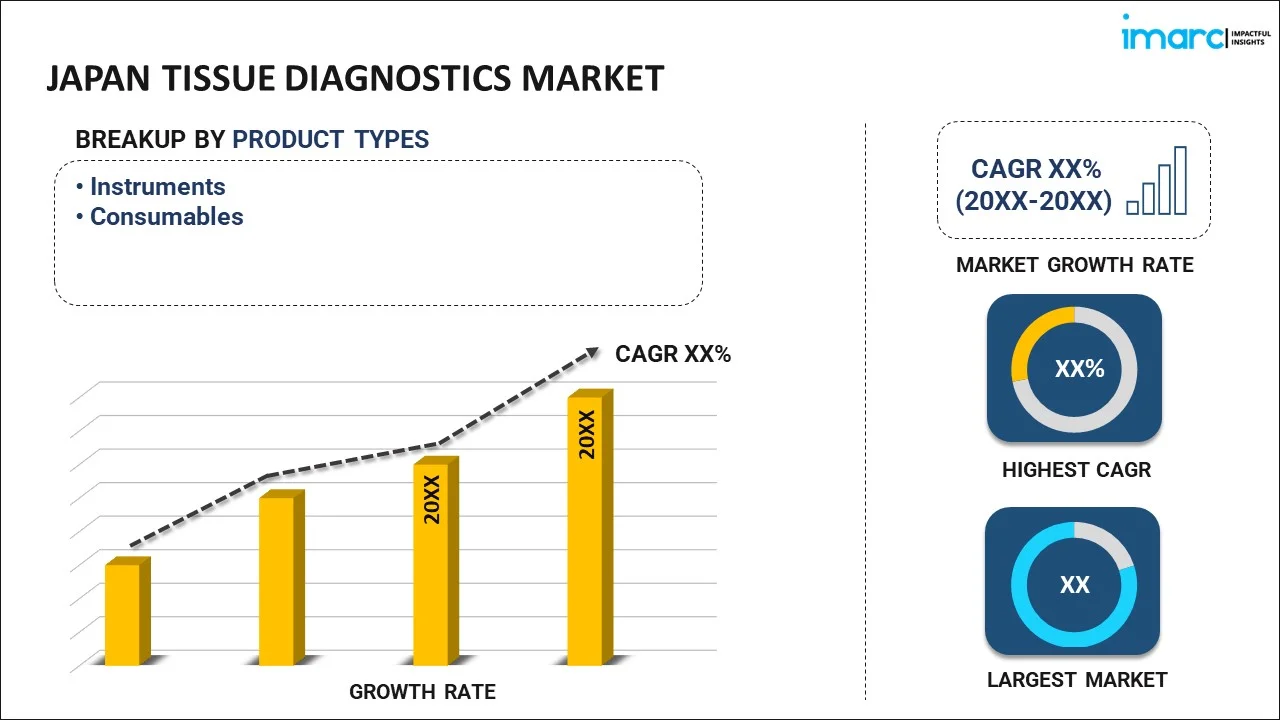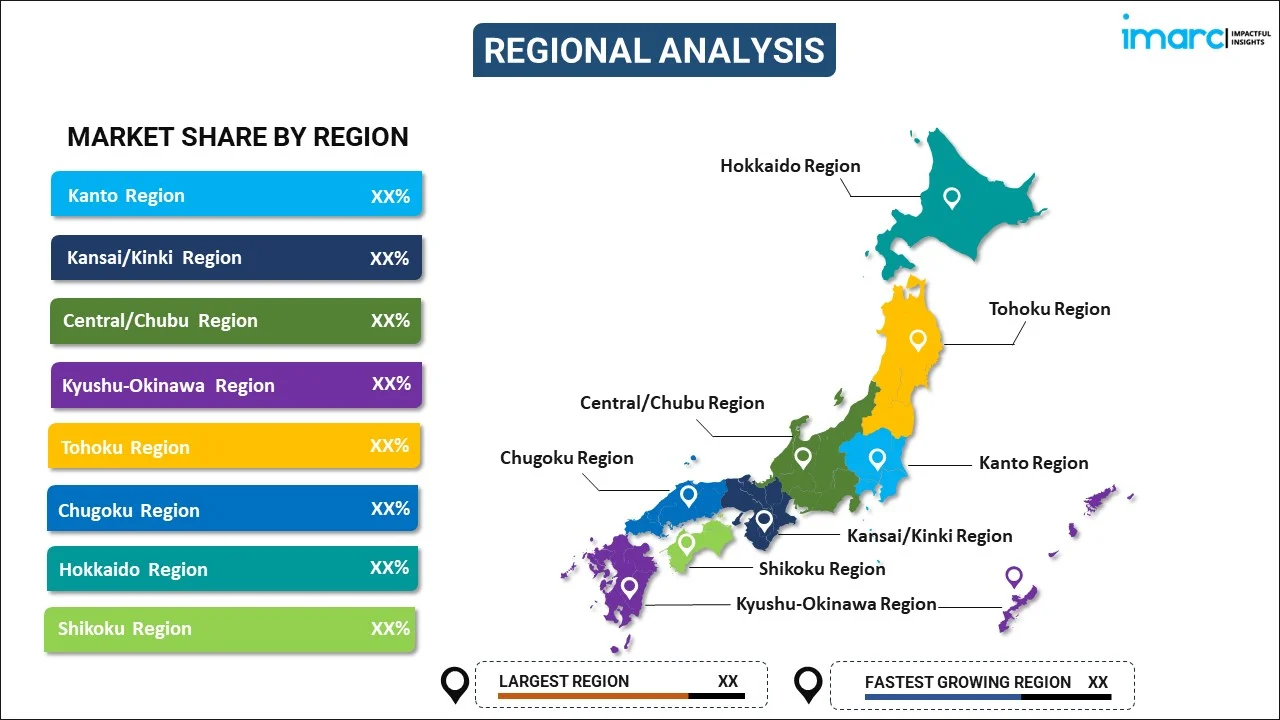
Japan Tissue Diagnostics Market Report by Product Type (Instruments, Consumables), Technology (Immunohistochemistry, In Situ Hybridization, Digital Pathology and Workflow Management, Special Staining), Disease (Breast Cancer, Gastric Cancer, Lymphoma, Prostate Cancer, Non-Small Cell Lung Cancer, and Others), End User (Hospitals, Research Laboratories, Pharmaceutical Companies, Contract Research Organizations, and Others), and Region 2025-2033
Market Overview:
Japan tissue diagnostics market size reached USD 243.6 Million in 2024. Looking forward, IMARC Group expects the market to reach USD 440.4 Million by 2033, exhibiting a growth rate (CAGR) of 6.3% during 2025-2033. The rising advances in technology, such as digital pathology, next-generation sequencing (NGS), and advanced imaging techniques, which have improved the accuracy and efficiency of tissue diagnostics, are driving the market.
|
Report Attribute
|
Key Statistics
|
|---|---|
|
Base Year
|
2024 |
|
Forecast Years
|
2025-2033
|
|
Historical Years
|
2019-2024
|
| Market Size in 2024 | USD 243.6 Million |
| Market Forecast in 2033 | USD 440.4 Million |
| Market Growth Rate (2025-2033) | 6.3% |
Tissue diagnostics is a crucial field in medicine that involves the microscopic examination and analysis of tissue samples to diagnose diseases and provide insights into their underlying causes. It plays a fundamental role in identifying various medical conditions, including cancer, infections, inflammatory disorders, and autoimmune diseases. The process typically begins with the collection of tissue specimens obtained through procedures like biopsies or surgeries. These samples are then processed, embedded in paraffin wax, sliced into thin sections, and stained with specific dyes to enhance visibility under a microscope. Skilled pathologists and histotechnologists examine these stained tissue sections to identify abnormal cellular structures, patterns, and markers. Tissue diagnostics help clinicians make informed decisions about patient treatment plans, including the choice of therapies, surgeries, or medications. Advances in technology, such as immunohistochemistry and molecular testing, have further improved the precision and specificity of tissue diagnostics, enabling personalized medicine approaches. This field continues to evolve, contributing significantly to early disease detection, prognosis prediction, and tailored patient care.
Japan Tissue Diagnostics Market Trends:
The tissue diagnostics market in Japan is experiencing substantial growth, primarily driven by several key factors. Firstly, the increasing prevalence of cancer necessitates advanced diagnostic techniques, fostering a surge in demand for tissue diagnostics. Additionally, the burgeoning geriatric population, who are more susceptible to chronic diseases, further propels this demand. Furthermore, technological advancements in the realm of molecular diagnostics have revolutionized tissue-based testing, rendering it more efficient and accurate. Also, there has been a significant rise in the awareness of personalized medicine among patients and healthcare providers alike. This has led to an increased emphasis on early disease detection and treatment customization, emphasizing the critical role of tissue diagnostics. Moreover, initiatives by government and private organizations to provide funding and grants for research in cancer diagnostics undeniably spur market growth. Apart from this, the continuous evolution in biomarker identification that is bolstering the development of new diagnostic tools is expected to drive the tissue diagnostics market in Japan.
Japan Tissue Diagnostics Market Segmentation: -
IMARC Group provides an analysis of the key trends in each segment of the market, along with forecasts at the country level for 2025-2033. Our report has categorized the market based on product type, technology, disease, and end user.
Product Type Insights:

- Instruments
- Consumables
The report has provided a detailed breakup and analysis of the market based on the product type. This includes instruments and consumables.
Technology Insights:
- Immunohistochemistry
- In Situ Hybridization
- Digital Pathology and Workflow Management
- Special Staining
A detailed breakup and analysis of the market based on the technology have also been provided in the report. This includes immunohistochemistry, in situ hybridization, digital pathology and workflow management, and special staining.
Disease Insights:
- Breast Cancer
- Gastric Cancer
- Lymphoma
- Prostate Cancer
- Non-Small Cell Lung Cancer
- Others
The report has provided a detailed breakup and analysis of the market based on the disease. This includes original breast cancer, gastric cancer, lymphoma, prostate cancer, non-small cell lung cancer, and others.
End User Insights:
- Hospitals
- Research Laboratories
- Pharmaceutical Companies
- Contract Research Organizations
- Others
A detailed breakup and analysis of the market based on the end user have also been provided in the report. This includes hospitals, research laboratories, pharmaceutical companies, contract research organizations, and others.
Regional Insights:

- Kanto Region
- Kansai/Kinki Region
- Central/ Chubu Region
- Kyushu-Okinawa Region
- Tohoku Region
- Chugoku Region
- Hokkaido Region
- Shikoku Region
The report has also provided a comprehensive analysis of all the major regional markets, which include Kanto Region, Kansai/Kinki Region, Central/ Chubu Region, Kyushu-Okinawa Region, Tohoku Region, Chugoku Region, Hokkaido Region, and Shikoku Region.
Competitive Landscape:
The market research report has also provided a comprehensive analysis of the competitive landscape in the market. Competitive analysis such as market structure, key player positioning, top winning strategies, competitive dashboard, and company evaluation quadrant has been covered in the report. Also, detailed profiles of all major companies have been provided.
Japan Tissue Diagnostics Market Report Coverage:
| Report Features | Details |
|---|---|
| Base Year of the Analysis | 2024 |
| Historical Period | 2019-2024 |
| Forecast Period | 2025-2033 |
| Units | Million USD |
| Scope of the Report | Exploration of Historical and Forecast Trends, Industry Catalysts and Challenges, Segment-Wise Historical and Predictive Market Assessment:
|
| Product Types Covered | Instruments, Consumables |
| Technologies Covered | Immunohistochemistry, In Situ Hybridization, Digital Pathology and Workflow Management, Special Staining |
| Diseases Covered | Breast Cancer, Gastric Cancer, Lymphoma, Prostate Cancer, Non-Small Cell Lung Cancer, Others |
| End Users Covered | Hospitals, Research Laboratories, Pharmaceutical Companies, Contract Research Organizations, Others |
| Regions Covered | Kanto Region, Kansai/Kinki Region, Central/ Chubu Region, Kyushu-Okinawa Region, Tohoku Region, Chugoku Region, Hokkaido Region, Shikoku Region |
| Customization Scope | 10% Free Customization |
| Post-Sale Analyst Support | 10-12 Weeks |
| Delivery Format | PDF and Excel through Email (We can also provide the editable version of the report in PPT/Word format on special request) |
Key Questions Answered in This Report:
- How has the Japan tissue diagnostics market performed so far and how will it perform in the coming years?
- What has been the impact of COVID-19 on the Japan tissue diagnostics market?
- What is the breakup of the Japan tissue diagnostics market on the basis of product type?
- What is the breakup of the Japan tissue diagnostics market on the basis of technology?
- What is the breakup of the Japan tissue diagnostics market on the basis of disease?
- What is the breakup of the Japan tissue diagnostics market on the basis of end user?
- What are the various stages in the value chain of the Japan tissue diagnostics market?
- What are the key driving factors and challenges in the Japan tissue diagnostics?
- What is the structure of the Japan tissue diagnostics market and who are the key players?
- What is the degree of competition in the Japan tissue diagnostics market?
Key Benefits for Stakeholders:
- IMARC’s industry report offers a comprehensive quantitative analysis of various market segments, historical and current market trends, market forecasts, and dynamics of the Japan tissue diagnostics market from 2019-2033.
- The research report provides the latest information on the market drivers, challenges, and opportunities in the Japan tissue diagnostics market.
- Porter's five forces analysis assist stakeholders in assessing the impact of new entrants, competitive rivalry, supplier power, buyer power, and the threat of substitution. It helps stakeholders to analyze the level of competition within the Japan tissue diagnostics industry and its attractiveness.
- Competitive landscape allows stakeholders to understand their competitive environment and provides an insight into the current positions of key players in the market.
Need more help?
- Speak to our experienced analysts for insights on the current market scenarios.
- Include additional segments and countries to customize the report as per your requirement.
- Gain an unparalleled competitive advantage in your domain by understanding how to utilize the report and positively impacting your operations and revenue.
- For further assistance, please connect with our analysts.
 Inquire Before Buying
Inquire Before Buying
 Speak to an Analyst
Speak to an Analyst
 Request Brochure
Request Brochure
 Request Customization
Request Customization




.webp)




.webp)












